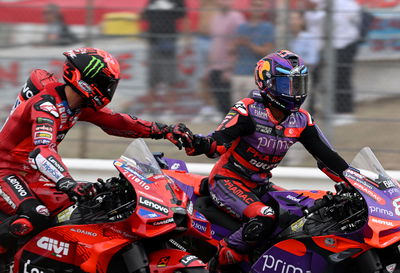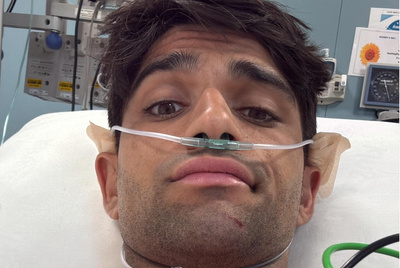Flag-to-flag MotoGP Misano race sparks F1-style team radio debate
Leading riders have their say on ship-to-shore radios during flag-to-flag MotoGP races

Sunday’s San Marino Grand Prix, which was hit by changeable conditions, has sparked a fresh debate on Formula 1-style team radios being introduced to MotoGP.
Light rain played a significant part in Sunday’s 27-lap grand prix at Misano, as a very brief shower on lap seven led to championship leader Jorge Martin pitting for his wet bike while running second.
Pramac rider Martin was the only one of the leading group to do so, with six riders in total heading to pitlane to swap bikes.
This proved to be a strategical blunder, however, as the rain soon faded and all six were forced back onto their dry bikes.
Martin ended up a lapped 15th and has seen his championship lead cut from 26 points after a dominant sprint win over Francesco Bagnaia to just seven points.
In recent weeks, there have been rumours suggesting Dorna Sports is looking to trial ship-to-shore radio communication in MotoGP - something that has been talked about and tested on a number of occasions in the past, but has never amounted to a real-world implementation.
This is something that has been commonplace in F1 and other forms of car racing for decades.
Information available to riders while on track is limited to pitboards, their bikes’ dashboard and what they can see and feel for themselves.
When asked if this was something that would have proved useful at the San Marino GP, race winner Marc Marquez says it would be good for the show but doesn’t believe the team would be able to better judge the conditions on track than him in a bike swap scenario.
“Those conditions, specifically the conditions from today, the rider decides [what is best] because even we don’t know [fully] and it’s impossible that the team knows how the race track is,” he said.
“So, the rider decides by feeling. Of course, if it’s from wet to dry, then that team communication can be useful because they can say to you if somebody is faster, time to come in, time to stay out. But when it’s from dry to wet, riders always decide.
“For the show? Yes [I’m in favour]. For the essence of the sport? No. But we are here for the show sometimes. So, it will be more interesting for the people at home.”
Second-placed Bagnaia echoed Marquez’s comments, adding: “It depends on the way they do, how they develop this kind of thing.
“But we have already every input possible around the track, on the pitboard and on our dashboard. So, I’m not in favour.”
Enea Bastianini, who was third in the grand prix, agreed with his Ducati colleagues while noting that the technology for the pit wall to accurately judge track conditions would need to be incredibly advanced to make it plausible.
“For this it depends on one rider to another on what’s happening during that situation, if the feeling is good or not,” he said.
“I think the guys from the team won’t say very well what the real condition is.
“Only we can say this. We would have to be very technological to have more information compared to us [on the bike].”
The “essence” of MotoGP matters
If MotoGP team radios were in use today, Martin most likely would have been told to stay out if his Pramac team’s weather radar was accurate enough.
Provided he didn’t crash, he would have been able to keep fighting for the podium and maybe could have vaulted ahead of Bagnaia who was nervous in the conditions.
If Martin had gone on to win the San Marino GP, he would have opened up his championship lead to 31 points over Bagnaia.
But Martin clearly didn’t know what the best thing to do was at that moment and he “rolled the dice”, as he later told the media, in the hopes that an early switch to wets would pay off with a dominant lead while the leaders who carried on slowed right down.
While credit would have to be given for that if it paid off, it’s so often the case in a 50/50 situation that you’re only seen as a genius if it works. On this occasion, it didn’t, and Martin needs to take it on the chin that he made a needless call at a critical moment in the championship.
As such, it has left him just seven points clear of Bagnaia. And now heading to the follow-up Misano contest in a few weeks in the Emilia Romagna GP, the stakes have been significantly raised.
With ship-to-shore radios, Martin would have been informed to stay out and the fans would have been denied a tighter championship picture.
A big argument for having team radios in F1 is that it gives fans an insight into what’s going on in the cockpit. But surely when it comes to watching sporting genius, the less you know the better? There is a safety application, with trials had where Race Direction can beam messages to riders' ears about track hazards. That could be an acceptable use of radios.
But, from a racing perspective, an unsure Martin being told to stay out by his team would have lessened the impact of the result he would go on to achieve - most likely a podium at least.
Those who stayed out on Sunday were rewarded in a big way. In the case of Bagnaia and Bastianini, they used their local knowledge and the fact they could smell that the track wasn’t wet enough to inform their decision.
Marquez, wisely, followed that local knowledge. They used nothing but their wits while racing at close quarters in iffy conditions and displayed why MotoGP riders deserve to be hailed as some of the best athletes in the world.
Saying that “for the essence” of MotoGP that team radios would be bad is an astute observation from Marquez for that very reason.
Should plans to introduce radios take on any meaningful form, the powers that be would do well to remember the 2024 San Marino GP, the spectacle it delivered, the heroes it created and the incredibly exciting championship picture it has produced…












